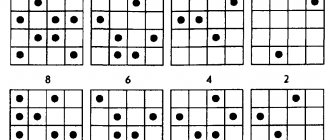In medicine and pedagogy there is no clear differential diagnosis of the problem of ZPR, ZRR and ZPRR. Parents are offered average recommendations, which should be suitable for correcting diagnoses of mental retardation, developmental developmental disorders and mental retardation in all children. But in practice this is far from being the case, and treatment does not always help. What is the cause of mental retardation, developmental retardation and developmental retardation in a child and how it is possible to remove the diagnosis, read in this article.
Features of the ZPR
Psychological characteristics of development are individual concepts, as a result - a personal selection of correctional classes and different rates of recovery. Many parents perceive the diagnosis of mental retardation as a death sentence due to insufficient information.
The disease lies between normal mental development and serious pathological abnormalities. This category does not include children with speech and hearing pathologies, as well as young patients with Down syndrome or other serious genetic diseases associated with the development and full functionality of the brain.
The main signs of ZPR are:
- unstable attention;
- lack of ability to concentrate;
- increased level of distractibility;
- low perception and memorization of speech information (visual information is easier to perceive);
- lack of skill to perceive and analyze information.
Children diagnosed with mental retardation need special treatment, but all of the above reasons for the development of the disease do not allow us to consider it a lifelong sentence. Through an individual study of the child’s characteristics, skills and needs, correctional techniques and exercises are selected.
ZPR, ZPR and ZPRR in children: symptoms and signs
Symptoms of ZPR, ZRR and ZPRR include:
- Poverty or lack of independent speech from 3 years of age;
- The child does not understand well and does not complete simple tasks;
- Slowly acquires new skills;
- Restlessness, attention deficit hyperactivity disorder;
- Neurotic reactions (nocturnal enuresis, tearfulness, fears);
- Closedness, isolation, absence or weak reaction to addressing a child with intact hearing;
- Autistic-like behavior;
A child with mental retardation, developmental retardation or developmental retardation may have individual symptoms or all of the above.
The problem with the classifications of symptoms of mental retardation, mental retardation and mental retardation is that they do not take into account the individual characteristics of the child, equate different children and adjust them to generally accepted norms. What is the reason for the delay in mental and speech development in a certain child? Let's figure this out with the help of system-vector psychology by Yuri Burlan.
Mental characteristics of children diagnosed with mental retardation, mental retardation and mental retardation
According to the system-vector psychology of Yuri Burlan, a person is born with certain vectors. Each vector has its own properties, unlike others, and its own psychophysical characteristics.
Knowing the child’s vectors allows him to develop correctly. After all, what is normal for one may be a pathology for another. In children with diagnoses of mental retardation, mental retardation and developmental retardation, the reasons for their appearance lie in developmental disorders in one or more of the following vectors.
- Sound vector
A child with a sound vector has a special sensitivity to the sounds and words of other people. These are the children who are silent for a long time, and then immediately begin to speak in sentences. When a child does not turn to adults, has little desire to communicate, does not speak, but understands everything and does what he is told - this may be a baby with a sound vector. If the sounds outside are unpleasant to his sensitive ear, then the psyche defends itself. The child “withdraws into himself” and his interaction with the environment is disrupted. This can happen when there are quarrels, scandals, noises in the family, loud household appliances and the like. A mother’s harsh voice and even unwanted words in a quiet voice that she says casually can be the cause of delayed psycho-speech development in children with a sound vector. When external conditions are too traumatic, such a child may be diagnosed with autistic-like behavior and childhood autism.
This is a severe disorder of communication and behavior with partial or complete loss of the ability to distinguish the meaning of the speech of others while hearing is preserved. The child cannot develop further because his psyche curls up into a ball inside himself. He needs help to “come out.” To do this, the rules of sound ecology at home must be observed. Close people, especially the mother, need to know the characteristics of such children. A child with a sound vector is not built like everyone else. And the more complex the psyche, the more fragile it is, the easier it is to break it, without even wanting it.
- Anal vector
Children with anal vector are slow and thorough. It is vital for them to finish the job they start, whether it’s sitting on the potty or fastening buttons. It is psychologically important for such a child to put an end to any matter.
If you rush him or interrupt him, he becomes stubborn and offended. As a reaction to stress, stupor may appear - the baby stops and cannot continue what he started. With chronic stress in the anal vector, thinking becomes excessively slow, and begins to get stuck on unimportant details. It is difficult to switch attention, the baby cannot absorb knowledge and does not acquire new skills. Developmental delays in a child with an anal vector appear due to a discrepancy between the pace of his mental activity and the demands of the environment. Stuttering may occur. It is necessary to distinguish the anal vector from others and create optimal conditions for development for the child.
- Skin vector
The skin vector is opposite in properties to the anal vector. A child with a skin vector is nimble, flexible, and able to quickly switch from one thing to another. Taking on several tasks and not finishing them is about him. If such a child is not raised correctly, he may experience mental retardation with attention deficit hyperactivity disorder.
Then it is difficult for him to learn and acquire skills due to distractibility and restlessness. Such a child, more than others, needs discipline and an adequate system of prohibitions, because in the skin vector, self-restraint has a special meaning. Parents, irritated by the child’s behavior, begin to sharply grab him, spank him, and scold him. This cannot be done - humiliation, causing pain, beating a baby with a skin vector inhibits its development.
- Visual vector
Children with a visual vector have the greatest emotionality and are prone to mood swings. To educate their sensuality is the task of parents. If a child with a visual vector has not been taught empathy for other people, then he may experience fears, throw tantrums, cry and make mountains out of molehills for any reason. When a child develops the habit of receiving emotions in this way, it disrupts his interaction with other people. A fear of communication arises, and then the child who is talkative at home remains silent and is afraid of strangers, and stuttering may appear.
Children with mental retardation: who are they?
Conventionally, the reasons for the appearance of PPD can be divided into 2 groups:
- The development of pathology due to the influence of social and pedagogical factors. Such children are classified as pedagogically neglected. Also in this category, hereditary predisposition plays an important role: antisocial parents = children with mental retardation.
- The development of pathology is associated with organic brain damage in the perinatal and postnatal period. During the diagnostic process, it is important to take into account all factors in order to be able to select comprehensive assistance.
The reasons for the development of pathology may be:
- frequent worries and stress of the mother during pregnancy;
- bad habits of the mother (smoking alcohol during pregnancy);
- chronic diseases of the mother;
- toxoplasmosis;
- brain hypoxia in the womb or during childbirth;
- difficult pregnancy;
- genetic disorders.
Types of ZPR
In psychology, there are 4 types of cognitive impairment:
- Structural genesis or hereditary infantilism - characterized by a low level of adaptation, learning information in a playful way, frequent emotional swings. Outwardly, such children are quite healthy and do not arouse suspicion, but emotional and volitional maturity is slowed down, which negatively affects the ability to develop skills and abilities.
- Somatogenic genesis - ZPR is caused by the presence of various kinds of diseases, both in the child and in the mother. The following diseases can develop against the background: frequent colds, allergic manifestations, chronic infections, congenital heart disease. Symptoms include: decreased cognitive activity and decreased attention.
- Psychogenic origin - against the backdrop of unfavorable conditions for upbringing, without corrective work, the child’s condition will only worsen, and in addition to the standard symptoms inherent in mental retardation, aggressiveness, lack of independence, shyness, isolation, and a sense of fear of everything new will appear. It is worth noting that unfavorable conditions for upbringing are not only a lack of attention from parents, but also excessive care. Do not deprive children of the right to choose and gain experience through trial and error.
- Cerebral-organic origin - injury to the child during labor or pregnancy. One of the most common types of pathology, which has less chance of full recovery.
The role of a child’s sense of security and safety in the development of mental retardation, mental retardation and mental retardation
Mom is the closest person to a child, and the most important. She gives him a feeling of security and safety. This is a prerequisite for the development of the baby’s psyche. Mom saves his life and psychological comfort. Then the child is able to develop the properties in his vectors to the maximum.
The loss of a sense of security and safety is fraught with a stop in his development. Then the still immature properties of the vectors begin to appear in the child, some of which are recognized as symptoms and signs of mental retardation, mental retardation and mental retardation.
Until the age of 6-7 years, the child’s unconscious connection with his mother is absolute - he adopts her inner state without words. If the mother is irritated, depressed, upset, and is subject to frequent stress, then the child will not feel protected. When a mother puts her psyche in order, the baby’s condition improves. A calm, balanced mother is able not to make mistakes in parenting, to react correctly to any child’s behavior and not to lash out at him.
When a mother finds out that her child has been diagnosed with mental retardation, mental retardation and mental retardation, she is overcome with a wave of fear for his future. Internal tension and feelings of guilt increase. She strives to give him the best, and if there is no result, despair sets in. This anxious state of the mother affects the child negatively. Mom needs to know what to do, gain confidence in her actions, and increase her resistance to stress.
Gaining knowledge at the “System-Vector Psychology” training is the best advice that can be given in this situation.
Who can diagnose a child with mental retardation?
There is a lot of information on the Internet regarding the symptoms and diagnosis of mental retardation, but usually the diagnosis is made by a pediatric neurologist on the recommendation of a pediatrician.
It is important to remember: a neuropathologist does not have the authority to single-handedly diagnose the disease!
- The final diagnosis is made solely by the decision of the psycho-medical-pedagogical commission.
- The PMPK has the right to both make and subsequently remove the diagnosis of mental retardation.
- The following specialists are present on the commission: psychiatrist, psychologist, speech therapist, defectologist, administration of the educational institution, teacher, parents of the child.
- Based on communication, studying the opinions of other doctors, testing to check skills and abilities, the commission draws appropriate conclusions.
As practice shows, mental retardation is diagnosed within 5-6 years (before school), and removed (subject to correctly selected corrective actions) at approximately the age of 10-14 years.
How to identify ZPRR?
ZPRD, if it is caused by congenital factors, can begin to manifest itself at a fairly early age of the child.
Signs of delayed psycho-speech development:
- 4 months : the child does not respond to the words and gestures of the parents, does not smile (these are also symptoms of autism);
- 8–9 months : absence of babbling (repetition of identical syllables);
- 1 year : the child is very quiet, makes almost no sounds;
- 1.5 years : does not speak simple words (“mom”, “give”) and does not perceive them, does not understand when addressed by name or with a request; may also not be able to chew;
- 2 years : knows and uses a very limited set of words, does not repeat new words after others;
- 2.5 years : uses no more than 20 words, cannot form a phrase out of two or three words, does not understand the names of body parts and objects;
- 3 years : cannot form a sentence on his own, does not understand simple stories from adults. Speaks too quickly, “swallowing” endings, or too slowly, drawing out words. In response to an adult’s address to him, he can repeat what was said verbatim.
A child with PVD at any age may experience increased salivation and an always slightly open mouth. Such children are characterized by hyperactivity, increased aggressiveness, inattention, fatigue, and poor memory. The child thinks very slowly, has an undeveloped imagination and a narrow range of emotional manifestations, experiences great difficulties in communicating with peers, and therefore avoids them. Physically, such children are also poorly developed and may even have cerebral palsy.
Symptoms of ZPRD also manifest themselves in organic changes. When examined using electroencephalography (EEG) or the evoked potentials (EP) method, disturbances are detected in the left hemisphere (it is responsible for speech development).
In general, the longer a child experiences difficulties with speech, the more his mental and mental development is delayed. After all, the older children are, the more information they receive from what they are told in dialogues with others. This is another reason to start treatment for PVD as early as possible.
ZPR and ZRR - what is the difference?
Quite a few parents do not pay much attention to the fact that their child speaks only in words when their peers speak in whole sentences. They believe that everything has its time and their baby will start talking soon. In medical circles, there are two diagnoses that most often go hand in hand and are strongly interconnected - these are speech development delay (SRD) and mental development delay (MDD). If symptoms of both are observed, then PVRD is diagnosed. If there is only a delay in speech development, then the baby can fulfill all the requests of the parents, understands what they say to him, but is simply in no hurry to speak out and speaks little and reluctantly. Emotional and mental development remains normal. Delayed psycho-speech development implies not only problems with speech, but also a lag in mental development. Before the age of 4, the diagnosis of SPD is quite rare, but in children over 5 years of age, the majority are diagnosed not only with speech retardation, but also with mental retardation. This is due to the fact that at this age the child actively explores the world, communicating with parents and peers, and if speech suffers, this leads to inhibition of mental development. That is why, if a pediatrician diagnoses a child with mental retardation, then parents should not expect that everything will normalize on its own, because difficult communication through speech with others will certainly lead to a disruption in the formation of the emotional-volitional sphere. Some parents resort to the help of defectologists, but with such a diagnosis, medical assistance is also necessary, because lost time is fraught with serious developmental deviations. Treatment of PVD in children should begin as early as possible.
Memo to parents
- CPR is not a death sentence; it is a disease that can be fully or partially corrected.
- According to statistics, a schoolchild can be diagnosed with mental retardation by the age of 10.
- To make a diagnosis, one doctor is not enough; you need to collect a PMPK.
- Without a decision of the commission, the child does not have the right to be transferred to individual education, to a specialized class, or to boarding school.
- There should be no pressure on parents from members of the commission.
- Parents retain the right to refuse to undergo the PMPK.
- The diagnosis of the commission is announced without the presence of the child!!!
- To make a diagnosis, a complex of symptoms is taken into account, and not just neurological indicators.
What needs to be done to remove the diagnosis of mental retardation from a child?
How is ZPR removed? First of all, this is carrying out corrective work, namely:
- visiting correctional schools;
- classes with specialists: psycho-neurologists, speech therapists, speech pathologists, etc.;
- the use of didactic games to develop the child’s skills and abilities;
- attending FEMP classes and learning to independently perform certain actions.
After you see that your child has fully caught up with his peers in terms of psychological development, you need to visit a consultation with a neurologist and receive a referral to a primary medical examination. The commission will again conduct a comprehensive survey and testing, and if all parameters are normal, the diagnosis made in childhood can be removed.








